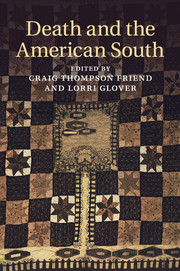'Death has always held high revel in the South, where malaria, Indian wars, the brutality of slavery, national defeat and a host of gray ghosts paved the way for today's high rates of gun ownership, obesity, diabetes, and capital punishment. The authors of these excellent essays cannot exorcise these Southern haunts, but they do explore with dark beauty how Southerners have made meaning in the teeth of often meaningless (and self-inflicted) pain. This is another five-star collection from the team of Friend and Glover.'
Stephen Berry - Gregory Chair in the Civil War Era, University of Georgia
'Death and the American South is a tenacious study - comprehensive, intuitive, and most importantly, provocative. Tightly argued chapters cover a wide array of phenomena, from experiences of collective sorrow and racial violence to issues of psychological control. The contributors interrogate historic memory in powerful ways. This is a highly absorbing book.'
Andrew Burstein - Charles P. Manship Professor of History, Louisiana State University
'Scholars have long awaited a volume like Death and the American South. While remaining attentive to the universal aspects of deathways, this impressive collection makes a strong case that the South had - and has - a distinctive culture of death. The result is a powerful, coherent collection of original essays.'
Erik R. Seeman - State University of New York, Buffalo
'Craig Thompson Friend's essay on scalping, Lorri Glover's study of founding father deaths, and Andrew Denson's reflection on the battle over Cherokee graves all show the region and one essential experience of life in new ways. For any student of Southern history this collection makes a valuable companion to the scholarship of Randy Sparks, Drew Gilpin Faust, Philip Dray, and others.'
R. Blakeslee Gilpin
Source: The Journal of American History
'… the eleven chapters that comprise Death and the American South are replete with intellectually stimulating and thorough research about everything from the specific ways by which colonists killed each other and displayed bodies in the early South to the conflicting strategies that the tourist trade has adopted to exploit the deaths of Native Americans. There are no weak links … The great strength of the collection is that each chapter contextualizes death in its own way.'
Ted Ownby
Source: The Journal of Interdisciplinary History
'The essays cover a sweeping chronological period from the sixteenth to the twentieth centuries, and that broad lens makes it possible to trace important themes across the region’s history, especially those themes involving the complex function of race in shaping southern attitudes toward death, dying, and the body.'
Randy J. Sparks
Source: North Carolina Historical Review



